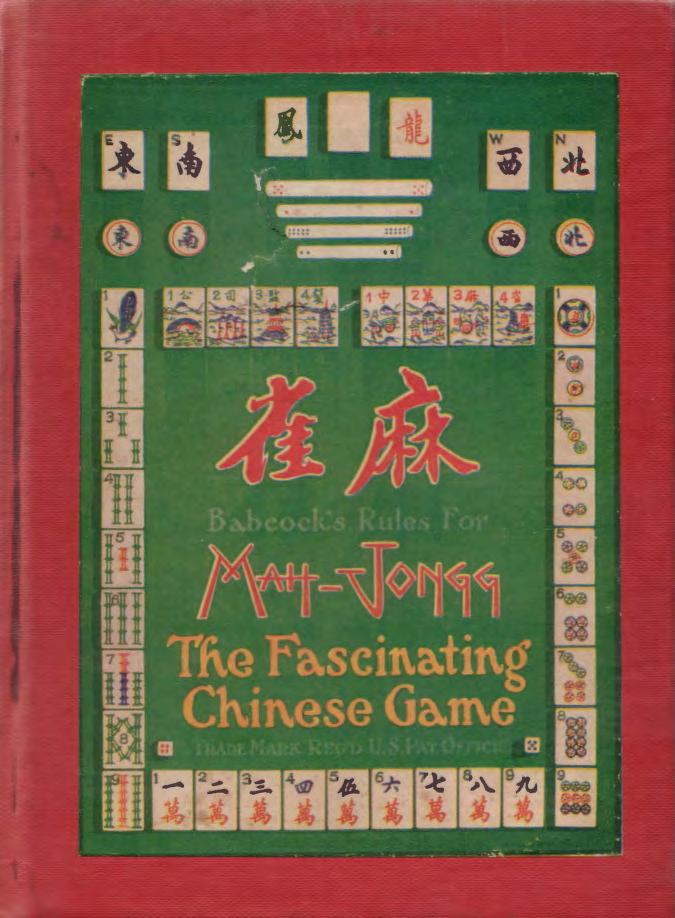How Can We Help?
AMERICAN MAH JONGG (Article 162)
National Mah Jongg League (NMJL) This style was created by the National Mahjong League (NMJL) in the late 1930s. Each player uses a card that describes approximately 30 pattern-based hands. The card is published with new patterns every April and can be purchased at the NMJL website. When a player purchases the card, they become a member of the NMJL and a portion of the proceeds from card sales go to selected charities.
The rules of the game, the categories on the card, and the conventions used to describe the valid combinations stay the same year after year, but the valid combinations change. The hands are arranged in categories like 2468, 369, 13579, and consecutive numbers. This style requires the player to gather singles, pairs, pungs (3 of a kind), kongs (4 of a kind), quints, or sextets to match one of the hands on the card. Flower tiles are used in many hands, and eight joker tiles can be used for anything but singles and pairs. One element that makes this game unique is the exchange of tiles called the Charleston, where unwanted tiles are passed multiple times before the first discard.
This style is probably the most common way to play in the United States, especially among Senior Citizens and the Jewish Community. In my opinion, it is the most challenging to learn but well worth the effort.
If you want to take lessons in person, please consider reaching out to a Mahj Life Instructor Guild Member https://mahjlife.com/instructor-guild-directory/
Buyers Guide
Player’s Reference Card
Standard Soft-Case Set
Easy Reader Set
Coins
Dice
Pushers
Racks
Table Covers
MahjTops
Highly Recommended Wiki Articles
Rules Not In Mah Jongg Made Easy (Article 00)
Top 10 Confusing and Complex Rules Demystified (Article 189)
American Mah Jongg Skills and Strategies Matrix (Article 210)
Fast-Track Study Guide Template (Article 211)
Downloads
American Mah Jongg NMJL Run-Through (PowerPoint presentation)
Current National Mah Jongg League Card FAQs with analysis e-book and video.
Charleston Force Category Cards
Mock American Mah Jongg Card (used in lesson videos)
Solitaire Bundle:
- AMJ Charleston Helper (used when playing solitaire)
- Holder
- Risers (I use 6 tile trays to create the tiered effect – stack them upside down with 3 in the back, 2 in the middle, 1 in front):
Links
Mahj Life American Mah Jongg Primers (Kindle and paperback)
Mahj Life Direct Links to NMJL Videos
The National Mah Jongg League posted 2023 FAQs. If the bright colors on black are hard to read, consider reading Modern Mahjong’s version of the 2023 FAQs.
American Mah Jongg Versions
Joseph Babcock, an American businessman, traveled to China in the 1920s. While there, he learned to play mah jongg. He published a book with simplified rules and imported tiles so other Americans could learn this fascinating game.
The National Mah Jongg League (NMJL) standardized the rules in 1936, added the Charleston, and began to publish their annual card with valid hands (including Flowers as part of the hand) where proceeds went to charities – this became known as American mah jongg. There are several versions, but they all use the same concepts as the NMJL (i.e., Flowers are part of the hand, the Charleston, annual card with valid hands) and share most rules but with different cards with hands:
- National Mah Jongg League (est. 1936); https://www.nationalmahjonggleague.org/
- Marvelous Mah Jongg (aka Houston; est. 2012) https://marvelousmahjongg.com/

Two other styles use a couple of American mah jongg concepts (i.e., the Charleston, NEWS) but they are played like Asian versions (i.e., flowers are bonus tiles; most hands follow four blocks (i.e., chow, pung/kong) and a pair convention, exceptions with all pairs and Thirteen Orphans/Angels [singles of all 1s, 9s, NEWS, Dragons and any tile paired]):
- Wright-Patterson Mah Jongg (est. 1920s) https://wrightpattersonosc.org/mah-jongg.htm
- British/Western Mah Jongg (est. 1920s) https://mahjongbritishrules.wordpress.com/scoring/special-hands/
Differences Between American Mah Jongg and Asian Versions
There are two differentiators in American mah jongg, 1) the annual card; Asian versions have stable rules and hand requirements; and 2) flowers are part of many hands; flowers. In Asian versions, flowers are bonus tiles. In some versions, flowers are optional (e.g., Chinese Classical), and Hong Kong New Style and Japanese/Riichi mahjong do not use flowers. In Filipino mahjong, winds and dragons are bonus tiles like flowers.
American mah jongg is not the only version that has a Charleston. Western mahjong, primarily played in the UK, India, Australia, and New Zealand, is a variation of Wright-Patterson Mah Jongg and includes a variation of the Charelston. Also, American mah jongg is not the only version that uses jokers. Malaysian mahjong has jokers (e.g., faces, fly), and Vietnamese mahjong has two sets of four jokers, each with specific uses.
Each Asian version is based on Chinese Classical, which requires four blocks and a pair. The blocks can be either a chow (e.g., 123; can only claim a discard from the player on the left) or pung/kong (e.g., three of a kind/four of a kind; can claim a discard from any player). Most versions also have two special hands: 1) seven unique pairs, and 2) Thirteen Orphans/Wondors (e.g., 1 and 9 of each suit, one of each wind, one of each dragon, plus any tile paired). Each version has a different scoring; some versions omit tiles or use tiles differently. All versions versions use house rules. For example, some Hong Kong mahjong groups play with two jokers. Some Filipino groups flip a random tile in the wall, and that tile is a joker. Some Taiwanese players do a three-round Charleston, all going to the left. Some versions have an extra block, so a winning hand has 17 tiles (e.g., Taiwanese, Filipino, Chinese-Fuzhou).
